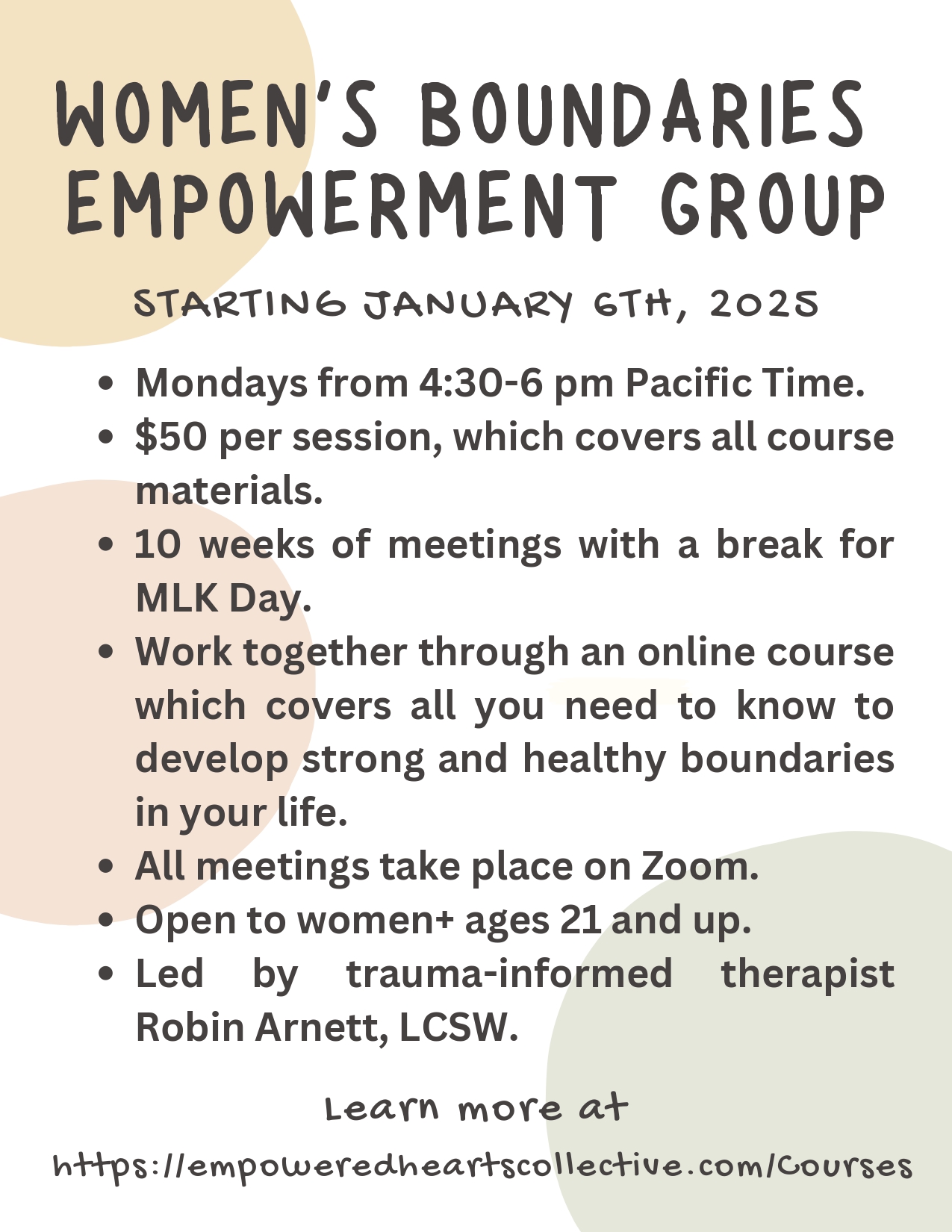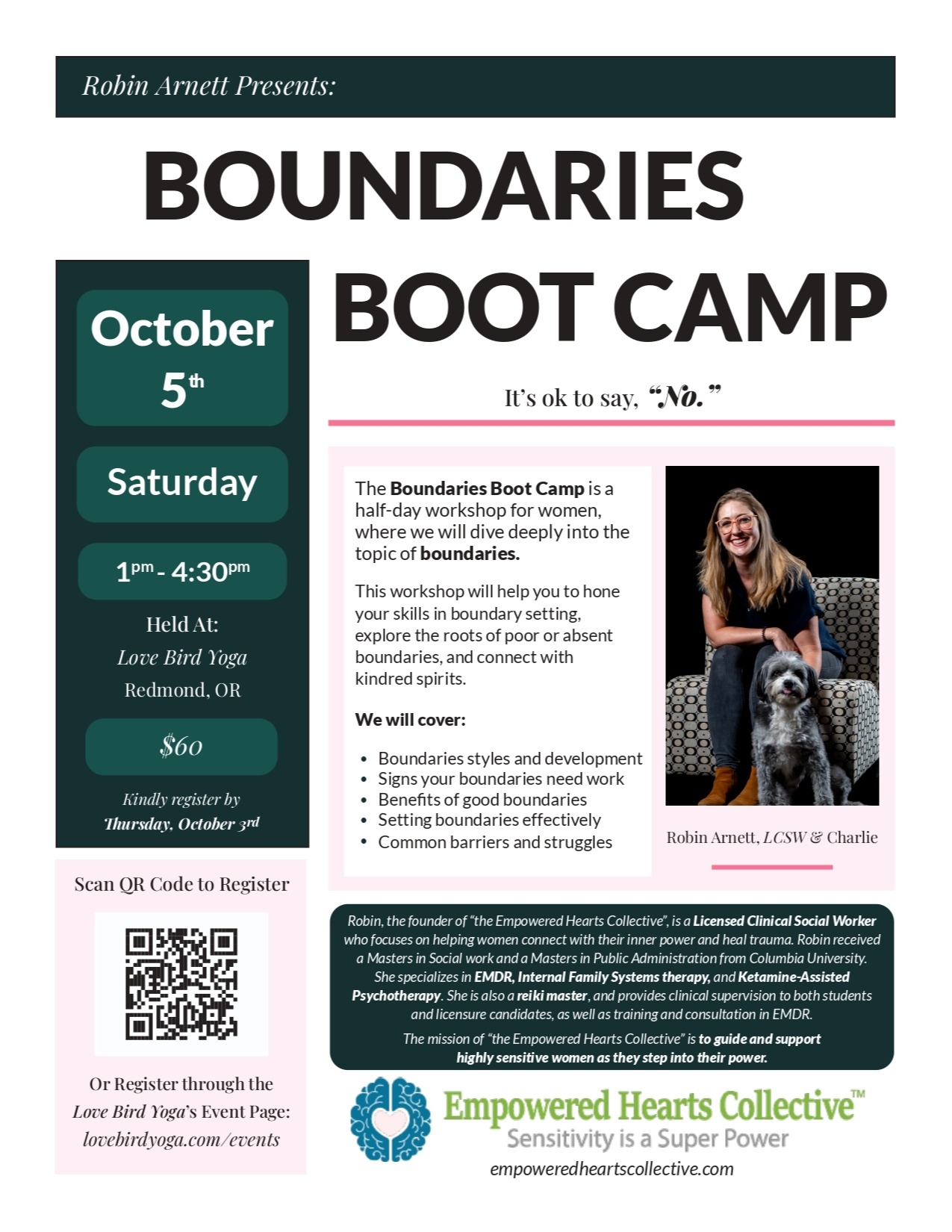Take the first step to stronger boundaries—unlock your free course, Module 7: Setting Effective Boundaries, from the Intuitive Boundaries Mastery Series.
Unlock Free ModuleEMDR Intensives 101
An Evidence-Based Approach to Holistic Healing
By Robin Arnett
See if this feels familiar - you're in your weekly therapy session, and things are getting real. After getting settled and giving some updates, you've started to dive into the past. Your therapist asked a few questions that sparked a deeper conversation, and you're really starting to get into it. Emotion is rising, and you're starting to feel some things clicking. Then, you look at the clock. There are only 10 minutes left in the session. It's time to wrap up. Your therapist doesn't want you to leave the session in tears, so they start to move toward helping you ground and planning for next time. Pretty soon, your time is up.
Sessions like these can be very frustrating, but are very common in an hourly therapy format. It's not easy or natural to go straight to the deep stuff within the first five minutes of getting together. Any meeting requires time to wind up and wind down, and that takes time.
Hour-long weekly sessions have been the traditional form of service delivery in behavioral health for as long as most of us can remember, but we need to ask - is this really the best way to heal? EMDR intensives offer an alternative approach that is able to achieve deep healing in less time through the power of efficiency and intention. In fact, evidence shows that intensive treatment can be more effective than standard treatment for a variety of conditions and diagnoses. If you are at a place where you are ready for change and tired of hitting a wall, intensives may be a great fit.
What is EMDR?
EMDR stands for Eye-Movement Desensitization and Reprocessing, and is an evidence-based modality that uses bilateral stimulation of the two-sides of the brain to facilitate deep healing and rewire neural pathways. EMDR can be used alongside traditional talk therapy, and other skills-based and behavior-oriented modalities like DBT, CBT, and motivational interviewing.
EMDR works by reprocessing past experiences and helping the brain to reorient toward more adaptive thought patterns and beliefs. It is effective in treating a broad range of mental health conditions, including PTSD, depression, anxiety, OCD, and phobias, and has a generalization effect of improving general well-being and relationships as well.
EMDR is often administered in a weekly therapy format within hour or 90-minute sessions, and while this can work well over time, EMDR intensives are beginning to be considered as the gold standard of care in EMDR treatment.
What is an EMDR intensive?
An EMDR intensive is a therapy session lasting longer than what is offered in a typical therapy setting. The Empowered Hearts Collective offers 3-4 hour EMDR intensives, and others offer full day sessions, or retreats that take place over several days at a time.
EMDR intensives can take place in a variety of settings, and can be integrated with other modalities such an Internal Family Systems therapy and ketamine-assisted psychotherapy. They typically happen in an in-person setting, but can be virtual as well, depending on client need and accessibility.
What are the benefits of EMDR intensives?
Efficiency
Think about taking a road trip. At the front end, you take time to load up your bags, gather snacks, and get yourself settled. You set up the navigation, get on the road, and you may even decide that you need a bathroom break within the first hour of the trip. Usually, the first 30 minutes to an hour of a drive are spent on slower roads on your way to the highway. The end of a trip is the same, as you take your exit and find your way to your exact destination. The process of getting started and winding down can be time consuming and slow. The middle, while you're cruising down the interstate, is where you cover the most ground. It's the same with therapy.
Any therapy session that you have will have a beginning, a middle, and an end. The middle of a session is where most of the processing really happens. If you're setting aside time for a 3-4 hour intensive, you only need to go through that process of settling in and winding down once, whereas it needs to happen every time if you are meeting hourly.
Intensives are also more efficient because they tap into the power of intention. As any therapist or healer can attest, our best work happens when our clients are ready and committed to change. It's a lot easier to phone it in to weekly therapy calls, giving updates, gossiping a bit, and venting. In contrast, if you're investing in an intensive, you need to be there to do the work. Nobody wants to waste half of their day in therapy if it's not going to be productive. When you sign up for an intensive, you send an internal message that it's time to dive in. Intention is so powerful. Intensive work is a way to harness your intention for change.
Integrating Modalities
EMDR can be integrated with numerous other modalities, including Internal Family Systems therapy and ketamine-assisted psychotherapy. Setting aside the appropriate time for this work allows for deeper processing and integration.
EMDR and IFS
Internal Family Systems therapy, or IFS, is an evidence-based modality that works with the theory of multiplicity of the mind to connect with internal “parts.” IFS work often involves guided visualization, and other approaches common to Gestalt therapy. It is often deeply meaningful to take time in an intensive session to connect with “parts” in order to get buy-in and explore fears and blocks. Rushing and pushing are reliable ways to trigger blocks and numbing. When it comes to healing, slow is fast. Slowing down to connect prevents stuckness and overwhelm, and intensives allow for that slow and intentional pace.
EMDR and KAP
Ketamine pairs well with EMDR because both approaches take advantage of the brain’s neuroplasticity. Ketamine-assisted psychotherapy has the effect of increasing a neurotransmitter in the brain that increases neuroplasticity. At the same time, EMDR rewires the brain toward more adaptive beliefs and thought patterns by rerouting neural pathways. Combining the two increases the efficacy of both approaches. Our neurology determines so much of how we move through the world, including our belief system, our self-esteem, and even the reality that we manifest. Using EMDR and KAP together works with the subconscious beliefs that can feel stuck to us even when we know better.
An EMDR intensives that integrates KAP begins with KAP dosing, and is followed by EMDR when the client is lucid enough to engage. This integration can happen within a single session, or as a part of a retreat.
Maintaining Relationships
Many people that pursue EMDR intensives already have relationships with therapists that they value deeply. Often, these therapists practice more cognitive or behavioral approaches and have a talk-therapy or relational focus. EMDR intensives are a great option for people who want to keep their relationship with a current therapist that does not practice EMDR in an intensive format.
Lower Dropout Rates
As you may have experienced if you've done therapy in the past, doing the work takes time. Every week, you have to set aside the same time, and life can get in the way. Sometimes life gets in the way so much that therapy has to take a back seat. Weeks can turn into months, and eventually you may just drop out completely. The intensive format allows you to get a meaningful piece of work done in only a few sessions, rather than having to find a way to fit in therapy around a busy life.
What's it like to do an intensive?
EMDR intensives through the Empowered Hearts Collective take place in-person to facilitate deeper connection. Prior to your intensive session, you will have completed at least one initial intake session online. This time helps with establishing rapport and treatment planning so that you can jump into the work right away on the day of your intensive. You may have more than one of these initial sessions as a part of your preparation work.
Intensive sessions begin with intention setting, grounding, and then connecting to internal “parts” with IFS. As mentioned above, EMDR integrates well with Internal Family Systems therapy, and the intensive format allows the time necessary to get agreement from the internal system to move forward. Spending this time prevents the work from getting stuck or blocked when things get heavy.
Once parts work has come to a natural stopping point, EMDR reprocessing and desensitization can commence. You will have previously identified a theme or a traumatic memory to work with that will be the focus of your session. Sometimes you are able to “clear” a target within one intensive, and sometimes you are not, but you will have time to move through a big piece of work. You can learn more about what EMDR looks and feels like here. You can take breaks whenever you need, and it often makes sense to take some time for a walk outside or a snack at some point within the session.
When you’ve reached a natural stopping place, the session will move toward a close. You’ll spend some time grounding, and reflect on your experience of the day. You will then make a plan for follow-up and care coordination if you’re working regularly with another therapist. It will often make sense to schedule several intensives over the course of a few months as a part of a comprehensive treatment plan.
Evidence-Based
Evidence shows that the EMDR intensive format has a statistically significant effect on reducing symptoms of PTSD, depression, and anxiety, as well as improved general well-being and interpersonal functioning. Research to support intensive treatment approaches is plentiful. Here are a few more academic articles on the subject:
- EMDR intensives treatment for complex PTSD
- Evidence for combining EMDR intensives with parts work
- Effectiveness of EMDR intensives in treating victims of crime
- Intensive treatment for severe PTSD
Moving Forward
If EMDR intensives are intriguing to you, you can learn more about logistics here or reach out directly here. The first step is to set up a consultation call to discuss options and create a plan. Intensives are appropriate for people coming from a variety of backgrounds, but it’s important to discuss fit and coordination of care.
Intention is everything when it comes to healing. Intensives may just be the next best step on your journey if you are ready for deep growth and change.


